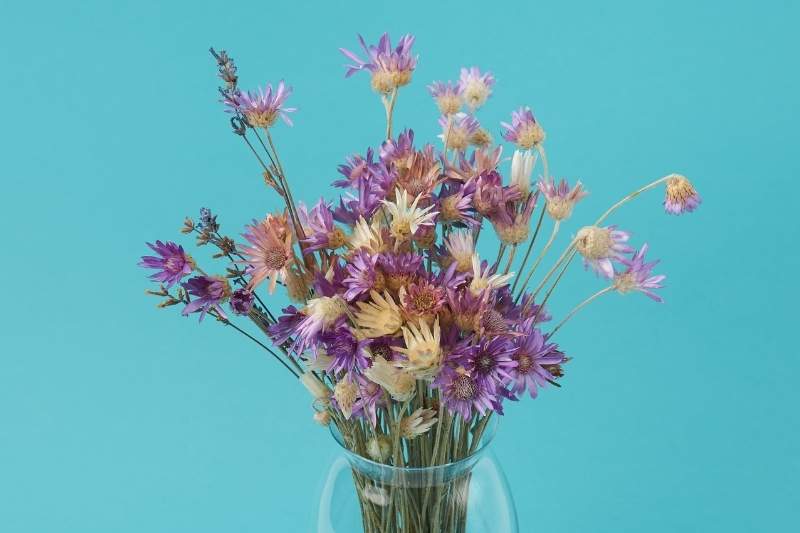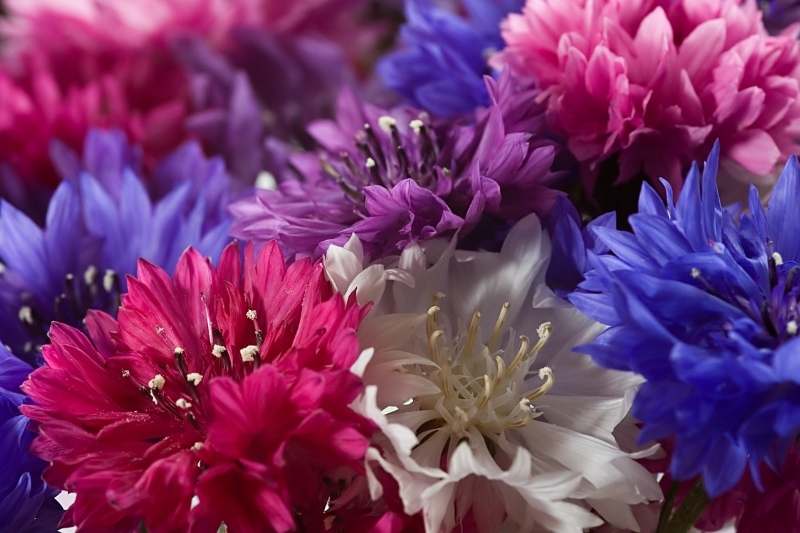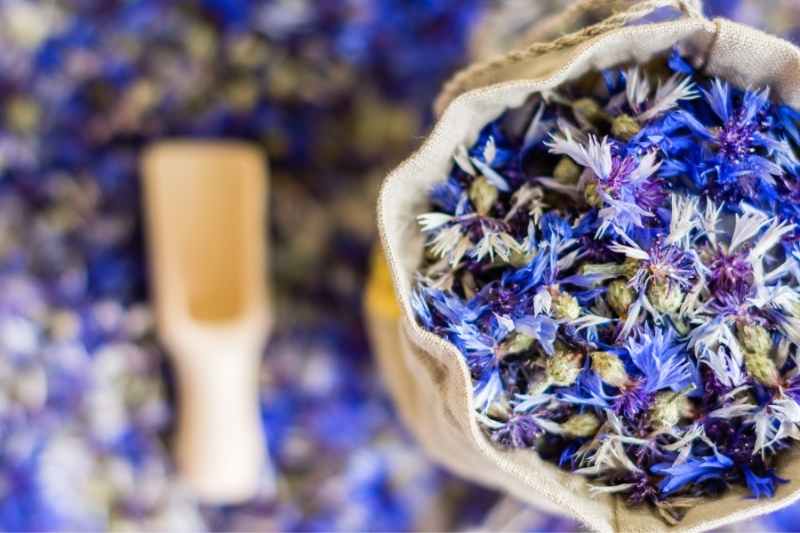Centaury or Centaurea is a perennial and sometimes annual plant with simple flowers. It comes in many varieties of shapes and colours. The most well-known varieties are Centaurea montana and Centaurea cyanus, also known as Cornflower. Some species grow wild in France.
They are easy to grow at home: they thrive in all soil types and tolerate drought.
Their simple wildflower beauty, prolonged blooming, and long stems make them excellent candidates for bouquets. Why not dry them to enjoy all year round?
Centaurea cyanus, which is edible and has soothing properties, also comforts you as a herbal tea, either on its own or blended with other dried plants. It also adds a cheerful hue to your flavoured teas.

The soft hues of dried centaury in a bouquet
Centaury Varieties and Colours
They are known for the intense blue flowers of Centaurea cyanus and the deep blue of Centaurea montana. However, Centauries come in many other colours.
- Some varieties have pink flowers, from the soft pink of Centaurea montana ‘Carnea’ to the vivid magenta of Centaurea dealbata ‘Steenbergii’.
- Others have yellow flowers: the pale yellow of Centaurea montana ‘Sulphurea’ and the large golden-yellow flowers of Centaurea macrocephala.
- There are also beautiful white varieties like Centaurea montana ‘Alba’ and dark varieties like ‘Black Sprite’ or ‘Jordy’.
- The most striking are bicoloured, such as the lovely Centaurea montana ‘Amethyst in Snow’ and ‘Purple Heart’, with white florets and a purple heart.
Let’s not forget their cousin, the delicate Serratula seoanei, with its bright mauve hue.
Their shape also varies—some slightly tousled, others like pom-poms, such as the beautiful Centaurea ruthenica.

When to Pick Centaury Flowers?
Depending on the variety, their picking season spans from April to September. Perennial varieties, like Centaurea montana, bloom from April to June. Centaurea cyanus or Centaurea moschata, both annuals, bloom a little later—from June to August for the former and July to September for the latter.
Pick them on a sunny day or at least when it's dry, ideally in the morning once the dew has evaporated.
Choose recently bloomed flowers at their peak or just opening, and avoid those already wilting.
Multiple harvests are possible as they bloom repeatedly. You may not always achieve perfect drying results—intense colours like those of Centaurea cyanus or darker flowers retain their colour better than lighter varieties. Don’t hesitate to experiment!

How to Dry Them?
Air Drying: The Simplest Method, Well-Suited for Centaury Flowers
Here’s how:
- Once you’ve selected your stems and flowers, trim longer stems if needed for uniformity;
- Bundle 5 to 10 stems together, removing leaves from the lower part where you’ll tie them;
- Secure the bundles with a natural tie like raffia. Tie tightly, as they’ll shrink while drying;
- Hang them upside down, ensuring the flower heads don’t touch. Use hangers, a grid, or a clothesline;
- Dry them away from light or wrap them in kraft or tissue paper. After a week to a month (depending on size), they’ll be dry. If they crumble easily, drying is successful.
Silica Gel Drying: For Better Colour Retention
This is ideal for light-coloured and pom-pom-shaped flowers.
Method:
- Line the bottom of a sealable container with silica gel;
- Place your flowers flat inside;
- Cover them completely with more silica gel;
- Seal the container and wait several days. Check and extend drying time if needed.
How to Store Them?
Keep dried flowers away from light. To preserve their colours longer, avoid direct sunlight and bright areas. For longevity, store them in dry rather than humid spaces.
Leïla’s tip: To prevent dust buildup, gently blow cool air from a hairdryer over your dried flowers.
Finally, arrange them in a suitably sized vase for floral compositions.
Using in Bouquets
Have fun creating lovely dried flower arrangements
Blue centauries brighten up typical dried bouquets in beige, white, and green tones.
You can craft a delicate bouquet by adding soft pink flowers. For a bolder look, incorporate violet or yellow. A deep burgundy adds sophistication.
You can also decorate candles with dried flowers or create wreaths and cloche displays.

Charming as candle wraps, centauries also make stunning dried bouquets
Cornflower Herbal Tea
Centaurea cyanus, also called Cornflower—a lovely tribute to its intense blue hue—can be brewed into a herbal tea. It tints infused drinks violet while offering its benefits. Known for its anti-inflammatory and throat-soothing properties.
Sow this annual in March/April for blooms from June to August. If drying solely for consumption, detach the flower heads from stems and remove leaves. Spread them in a single layer in a dry, ventilated, dark place. After a few days, they’ll be dry. Store in kraft paper for up to 1–2 years to preserve their properties.
Cornflowers have a mild taste. Enjoy their benefits blended with other dried herbs in tea or mixed into flavoured teas like Earl Grey.




































Comments